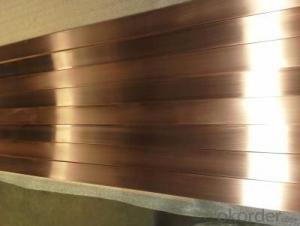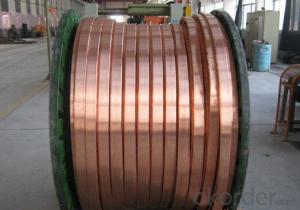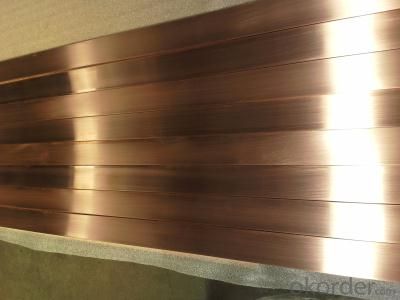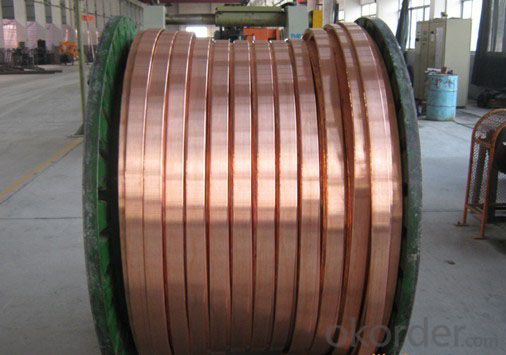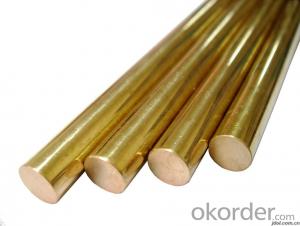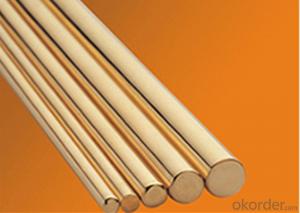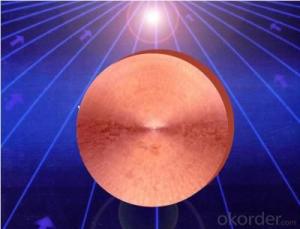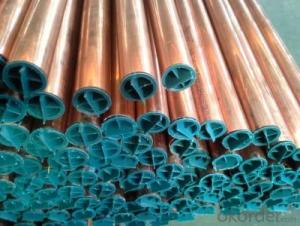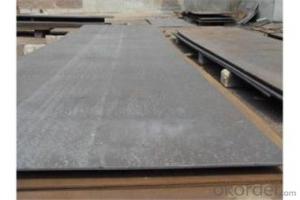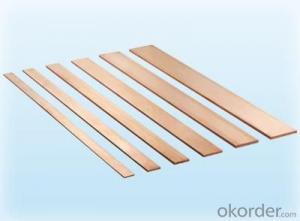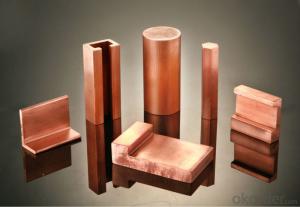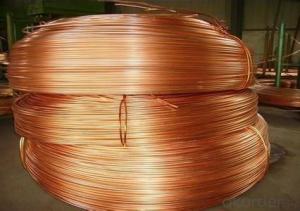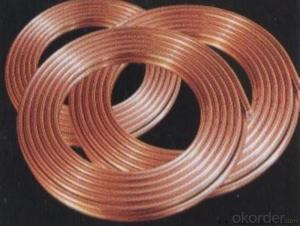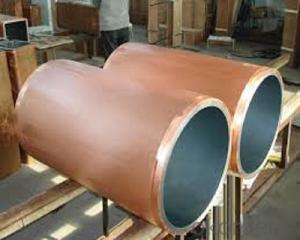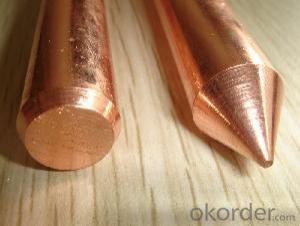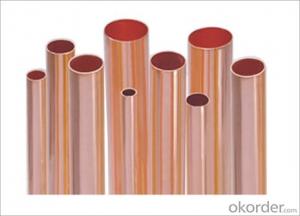Oxygen-free Copper Busbar And Copper Bar With High Conductivity
- Loading Port:
- Shanghai
- Payment Terms:
- TT OR LC
- Min Order Qty:
- 500 kg
- Supply Capability:
- 10000 kg/month
OKorder Service Pledge
OKorder Financial Service
You Might Also Like
Product: Oxygen-free copper busbar and copper bar with high conductivity
Brand: Flying Wheel
Type Specifications: T2, TU1, TU2, TAg
Copper busbar is a strip or bar of copper that conducts electricity, often produced with high purity oxygen-free copper ingot through extrusion and drawing processes, usually used in high and low voltage electrical equipment, switch contact, electrical distribution equipment, and bus slot, etc.
Oxygen-free copper busbar and copper bar with high conductivity Specifications
Type | Cu%(WT) | W%(WT) | RWMA | Density | E-conductivity(Min) | heat conduction | thermal expensivity | |
Class | (Min) | Hardness | ((W/mK)) | |||||
(Min) | ||||||||
CuW55 | 45±2 | Balance | 10 | 12.30g/cm3 | 49%IACS | 125HB | ~260 | ~11.7(10-6/K) |
CuW60 | 40±2 | Balance | 12.75g/cm3 | 47%IACS | 140HB | |||
CuW65 | 35±2 | Balance | 3.30g/cm3 | 44%IACS | 155HB | |||
CuW70 | 30±2 | Balance | 13.80g/cm3 | 42%IACS | 175HB | ~240 | ~9.7(10-6/K) | |
CuW75 | 25±2 | Balance | 11 | 14.50g/cm3 | 38%IACS | 195HB | 200~230 | 9.0~9.5 (10-6/K) |
CuW80 | 20±2 | Balance | 12 | 15.15g/cm3 | 34%IACS | 220HB | 190~210 | 8.0~8.5 (10-6/K) |
CuW85 | 15±2 | Balance | 15.90g/cm3 | 30%IACS | 240HB | 180~200 | 7.0~7.5(10-6/K) |
Application: Copper busbar is a strip or bar of copper that conducts electricity, often produced with high purity oxygen-free copper ingot through extrusion and drawing processes, usually used in high and low voltage electrical equipment, switch contact, electrical distribution equipment, and bus slot, etc.
Production Equipment
750-1500kg main frequency induction copper melting furnace, 80MN water seal extruder, LG60 high speed two-roll cold pilger mill, straight-line wire-drawing machine, copper tube/pipe straightener, polisher, 84′ copper coil winding machine, straightening-cutting & pancake coiling machine, thermoplastic packaging machine, 1.2T continuous bright annealing furnace.

80MN extruder

Continuous bright annealing furnace
Testing Devices
spectrum analyzer, atomic absorption analyzer, spectrophotometry, analytical balances, metallurgical microscope, eddy current flaw detector, metal tensile testing machine, eddy conductivity instrument.

Hardness tester

Spectrum analyzer

Metallurgical microscope

Metal tensile testing machine

Atomic absorption analyzer
Process
refined copper — smelting & casting — extrusion — rolling — drawing — straightening-cutting/forming of pancake coil — bright annealing — packaging — finished goods.
Standards
GB/T 1527-2006 Drawn tube of copper and copper alloys
GB/T 16866-2006 Dimensions and tolerances of copper and copper alloy seamless tubes
GB/T 4423-2007 Copper and copper-alloy cold-drawn rod and bar
GB/T 5231-2001 Wrought copper and copper alloys chemical composition limits and forms of wrought products
GB/T 5585.1-2005 Copper or aluminium and its alloy bus bars for electrical purposes—Part 1:Copper andcopper alloy bus bars
GB/T 17791-2007 Seamless copper tube for air conditioner and refrigeration equipment
GB/T 19850-2005 The seamless round copper tubes for electrical purposes
GB/T 26024-2010 Seamless copper and copper alloys tube for valves on air-conditioning and refrigeration system
ASTM B280-2008 Standard Specification for Seamless Copper Tube for Air Conditioning and Refrigeration Field Service
EN 12735-1:2001 Copper and copper alloys Seamless,round copper tubes for air-conditioning and refrigeration Part 1:Tubes for piping systems
EN 12735-2:2001 Copper and copper alloy – seamless round copper tube/pipe for air-conditioning and refrigeration system – for equipment
JIS H3300-2009 Seamless copper and copper alloy tube/pipe
- Q: I know the actual difference but when is normal copper clad used? can it be used with a UV light box and sodium hydroxide and ferric chloride in the same method? if so, why buy photo resist? if not, what method do i use copper clad to make a PCB? thanks
- You can start with a plain copper clad board and add a photoresist coating to convert it into a photoresist board. You used to be able to buy spray-on photoresist but nowadays it's common to apply the coating as dry film that you laminate onto the board with a hot roller device. But for small quantities it's usually cheaper, and definitely more convenient, to buy pre-coated boards. You'd start with a plain copper clad board if you weren't going to use a direct photographic method to create the mask that protects the copper from etching. You might use an indirect method, for instance by creating a silkscreen and then silkscreening the etch protection to the board. In the distant past I used to use an enamel-ink pen to hand-draw the mask. That's easy, cheap and it works well for layouts that don't require fine pitch. Or you can use a non-etch method to remove the unwanted copper: commercially you'd probably use a CNC router to do that but for a hobbyist a Dremel with the right bit would work just fine for simple layouts.
- Q: What about the water inlet of the cabinet air conditioner copper pipe?
- It must be dried with nitrogen to get into the system, or there will be moisture and malfunction in the system.
- Q: Outline the steps involved in preparing copper pipe for a straight tubular lapped brazed joint?
- When passing a truck move to the far side of the adjacent lane and full speed ahead, don't worry about the limit, get in front as soon as possible then slow down. Drive int the areas where car tires go,NOT the center of lane. That's where the cars drip oil and traction is really reduced, you can walk out in the street and look down and see the color difference. Use a clear visor ,not tinted, sun glasses for bright days. Even a light tint is dark at night and you WILL get caught out at night.
- Q: i need this for a project and i just cant seem to find out where you can find any kind of copper anywhere. but it would be great if you help thanks.
- Wire. Pennies have very little copper in them anymore.
- Q: I can‘t sleep, I nearly fall asleep but then suddenly wakes up again and doesn‘t feel like sleeping. When I do fall asleep late at night/early in the morning I dream very intense and has weird nightmare sort of dreams. Can this be related to copper pipes in the wall right next to my bed? My bed is really close to the wall. Sometimes I think there is someone in the dream, and I wake up looking around. I‘m usually sweating and can‘t fall asleep. It sucks! Can somebody help me with this? I want to get a nice rhythm in where I fall asleep right away!(When I tried to breath at a minimum,letting very little oxygen in my lungs, I get really tired, but its scary, so I want do it lol)
- To help yourself relax, inhale slowly for eight seconds. Exhale slowly for eight seconds. Make sure you let out enough air. If you are having a hard time sleeping because of your bed being near that wall, move your bed to another part of the room where you would feel more relaxed. I hope you will be able to have more restful sleep. Good Luck.
- Q: Which is good for cutting copper tubes?
- The brass cutting recommended Shanghai high volatile, high volatile Shanghai decoration materials Co., Ltd. specializing in the production of sales of metal processing, laser cutting, shearing, bending, slotting and other metal materials, good products and professional sales and technical team, to provide quality products and satisfactory service to customers, the company is willing to work with all partners. With the progress of sharing, outstanding future!
- Q: Air conditioning copper tubes are often heard 2 points, 3 points, 4 cents, exactly how much?
- Several in charge of the general is used for waterways above the argument, 2 in charge of 9.523, in charge of 12.74, in charge of 15.88 for the name of different plastics, 4 divided into 206 points for 253, 16, these are refers to the outer diameter
- Q: How do I remove compression fittings from an existing copper pipe?
- This Site Might Help You. RE: How do I remove compression fittings from an existing copper pipe?
- Q: Well, which one is better for killing heat?or at least producing the least amount of it.I will be covering the top half's of both heat sinks(cpu and gpu) with one of these and I just need something that produces less heat than the other, dissipates it more, prevents heat more, etc. I just ned to get rid of heat, ha ha. I know it sounds silly to put this on top, but I have to for better fan airflow, its for my xbox 360, but i figured overclockers would know more about this.
- Copper has higher thermal conductivity, therefore, it's ideal for that purpose. If you want to dissipate heat, you would need high amount of surface area of copper (like lots of fins). Wiztek, that is not true. The copper absorbs heat better than aluminum but aluminum releases heat better than copper is a BIG MYTH. Thermal conductivity doesn't matter if its heat flowing in or out. THERMAL CONDUCTIVITY Copper: 380 W/(m·K) Aluminum: 200 W/(m·K) These values are always constant whether heat is flowing in or out. In other words, the ability to absorb heat and the ability to release heat are the same thing. The reason why copper based aluminum heatsinks are more popular is because its cheaper to manufacture, lighter, and the real world performance difference between copper-core Al heatsinks and 100% copper heatsink is rather small while the difference between copper-core Al vs 100% Al is larger. Copper is also very expensive, twice as heavy as aluminum, soft, and vulnerable to corrosion. Maybe that's why some copper heatsinks are nickel plated to prevent corrosion.
Send your message to us
Oxygen-free Copper Busbar And Copper Bar With High Conductivity
- Loading Port:
- Shanghai
- Payment Terms:
- TT OR LC
- Min Order Qty:
- 500 kg
- Supply Capability:
- 10000 kg/month
OKorder Service Pledge
OKorder Financial Service
Similar products
Hot products
Hot Searches
